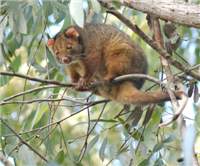Family
PseudocheiridaeGenus
Pseudocheirus
Species
peregrinusThreats/Control Methods - Regional
Habitat loss from land clearing for urban development and agriculture are contributing to the increasing rarity of this species across Australia. Feral Cat (Felis catus ) and Fox (Vulpes vulpes ) predation is high in the forest and woodland environment where territories overlap.
Threats/Control Methods - Local
The loss of mature trees from the suburbs directly limits the population of Ringtails in the suburban environment. Ongoing predation by free roaming domestic Cats (Felis catus ) and Dogs (Canis familiaris) is also a major threat, as possums are very traumatised after being bitten and rarely survives a bite, regardless of its severity. In urban areas, Ringtail Possums can get run over by cars, or get caught on electric wires.
Local/Urban Actions
Canberra residents can encourage these mammals into the surrounding region by participating in tree planting or bush regeneration activities with local Landcare groups or with Greening Australia. Pet owners can help provide a safe suburban environment by providing a stimulating indoor environment for their pets, keeping dogs on a leash in nature reserves and by installing an outdoor cat enclosure.
Common name/s
Common Ringtail Possum, Banga, Rufous Ringtail, Southeastern Ringtail
Distinguishing Features
The common Ringtail Possum is the smallest species of ringtail possums. The body length of an adult is 30-35 cm and its strong tail is roughly the same size. The tail is curled up when not being used for climbing. The upper body colouring is brown and reddish with a lighter grey under body colouring. It is distinguishable from other possums by its smaller ears and white patches of fur on and above the ears. The tail has a noticable white tip.
Similar Species
The light grey coloured Brushtail Possum (Trichosurus vulpecula) has noticeably larger ears and lacks the very long, white-tipped tail.
Distribution
The Ringtail Possum is found in VIC, SA, NSW, ACT and QLD.
Country of Origin
Australia
Survey Techniques
This species was identified visually during night searches and with scats.
Conservation (Pet/Pest) Status - National
Generally common, however the Western Ringtail Possum (Pseudocheirus occidentalis) is listed under the EPBC Act 1999 as a Vulnerable species.
Conservation (Pet/Pest) Status - Regional
This species is declining steadily in areas becoming increasingly developed.
LSCCES Population
This was the second most commonly recorded native mammal in the Lower Sullivans Creek Catchment area.
Associated vegetation community
This species inhabits a variety of vegetation types across Australia where shrubs form dense foliage, including forests, woodlands and tree-lined suburban areas.
Limiting Resources
Ringtail possums are arboreal (tree-dwelling) marsupials, therefore depending on the availability of mature trees within their territory. In this way, their distribution and abundance is limited by the availability of nest sites. Like the Brushtail Possum (Trichosurus vulpecula), this species has adapted well to living close to humans and it is common in the suburs of cities in its range.
Breeding
Ringtail Possums typically have litters of two offspring each year, though they can sometimes produce up to four young. The breeding season occurs in the cooler part of the year from May to December. Some older females manage to raise two litters over a breeding season. Young Ringtails emerge leave their mother's pouch after about four months, and are weaned after about six months. When the mother is feeding, the male carries the young on his back and cares for them. This is the only species of possum currently known where the male helps to care for the young.
Behaviour
Unlike many other species of possum, Ringtails are very social and live in small groups together. The group is usually made up of one adult male, one or two adult females and their offspring from the previous breeding season. They are very territorial and use scented secretions to mark the boundary of their territory. They are also very vocal. Ringtail Possums are an arboreal (tree dwelling) species and very rarely come down to the ground. Being nocturnal, they typically sleep during the day in tree hollows, house roofs and other dark sheltered places, and forage at night. They build a round nest of grass and shredded bark for resting during the day, called a 'drey'. Possums live for three to six years in the wild.
Functional Group
Food Species
In their natural environment, ringtails feed on eucalyptus leaves, shrubs, flowers nectar and fruit. They have a low metabolic rate, which helps them compensate for the low energy intake, that is a result of their specialised diet. In urban areas, ringtails will also eat rose buds and other flowers commonly found in suburban gardens.
Predators
European Red Foxes (Vulpes vulpes ), Dogs (Canis familiaris), Cats (Felis catus ) and birds of prey predate Ringtail Possums.
Interesting Fact
Unlike brushtail possums, they are not considered pests in suburban areas and do not nest within homes or human structures.
References - (reader suitability of references, P=Primary teachers, S=Secondary students, T=Tertiary students and researchers)
Online Publications:Australian Museum. 2007. Common Ringtail Possum Fact file. [online]. Available at:http://faunanet.gov.au/wos/factfile.cfm?Fact_ID=301 P, S, T
Tidemann, C., Roscoe, T. and Mitchell, B. 2006. Mammals of the Lower Sullivans Creek Catchment, Canberra ACT. Prepared for the Life in the Suburbs project using data from the Lower Sullivans Creek Catchment Ecological Survey (LSCCES). Australian National University. Canberra. [online]. Available at: http://www.lifeinthesuburbs.com.au/category.php?id=65 S, T
Welsh, P. 2002. Pseudocheirus peregrinus. Animal Diversity Web. [online]. Avaliable at: http://animaldiversity.ummz.umich.edu/site/accounts/information/Pseudocheirus_peregrinus.html P, S, T
Researchers: Hedda Ranson-Elliott and Naomi Hogan

 Top
Top Top
Top